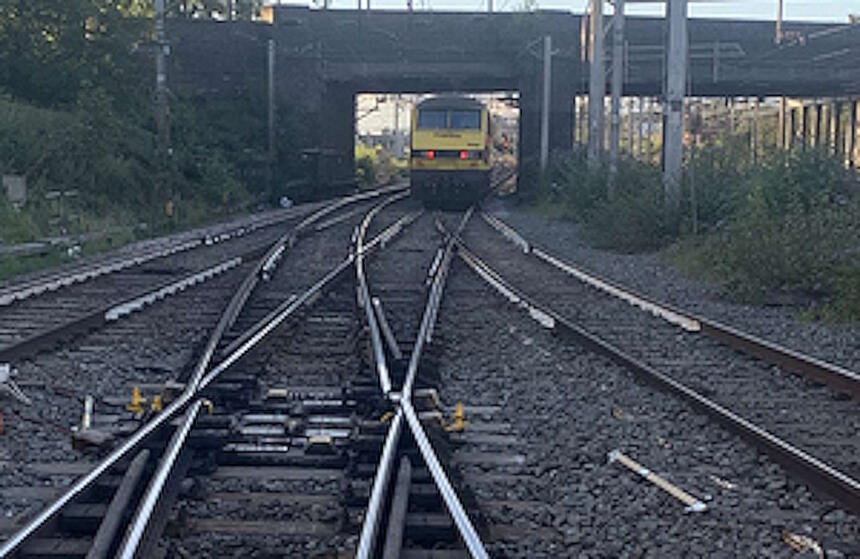The Rail Accident Investigation Branch has launched an investigation after an electric locomotive passed a red signal.
The locomotive, operated by Freightliner, passed the signal at Stafford Trent Valley No 1 Junction at around 16.42 on Tuesday 22 August.
It was on a test run between Nuneaton and Crewe and passed through points before it stopped at the junction.
There were no injuries, and the locomotive did not derail although there was some damage to the points which had been run through.
However, the location of the locomotive once it had come to a halt conflicted with a route which had been set for another train. Neither that train nor any others were nearby at the time.
The investigation will be independent of any other inquiry set up by the railway industry or the regulator, the Office of Rail and Road.
The probe will set about identifying the sequence of events prior to the incident. Consideration will also be given to the actions of any people involved and anything which may have influenced them as well as the management of drivers who work for Freightliner, their training and competence.
Underlying management factors will also be examined as well as the configuration and performance of signalling equipment and the locomotive itself.

Wouldn’t it be better that the train was automatically braked at the last safe braking distance point
1st port of call, Blame the Driver.????
To be fair it was totally the drivers fault this time
The brakes have clearly automatically come in once the driver Spadded the signal
(otherwise the train would’ve been long gone and only could be stopped by an emergency broadcast from the controlling signaller or a red aspect on the next signal)
AWS alerts the driver but will not apply the brakes if the driver responds to the alert hooter by cancelling it within a specified time (pushes cancelling button). AWS alert occurs at the ramp (yellow ramp between rails, triggers eloctromagnet on loco to to initiate alert or ‘clear signal’ bell) 100 metres or do before the loco reaches the signal; it is not an automatic train stop that physically applies the brakes such as are used on LUL. This is because of the much higher speeds of main line trains which would damage the equipment and possibly the trains.
If the driver does not cancel the alert at the first yellow (caution) signal of the sequence within a set time (used to be seven seconds) the brake is then applied automatically, but this is a response to a yellow signal initially and there is plenty of time and distance to stop the train. Further yellows and the final red will repeat the procedure.
If the signal is clear (green) the alert hooter does not sound and a bell rings; the driver needs to take no action in response to this. If the AWS is not working and the loco cannot be taken out of traffic, a second driver must rode in the driving cab to observe signals.
It would not be right to speculate on the causes of this incident without knowing more of the facts, and that’s what the RAIB does.
The driver could have cancelled AWS signal my have been fitted with TPWS this will stop train
AWS reset times are 2 to 3 seconds. If not cancelled within this time the brakes will apply. TPWS (Train Protection Warning System) will automatically apply the brakes if the train passes over the Train Stop grids located at the danger signal. TPWS overspeed grids are also usually located before signals to stop trains that are travelling too fast towards a red signal. These are usually set at around 45mph but this varies depending on location and line speeds. This is to stop a train travelling too fast towards a red signal, or permanent speed restriction, or stop blocks in a bay platform, over and above what is deemed a safe speed to approach said stop point. Not everywhere is fitted with TPWS however, the risks of the area are taken into account when installing the system.
AWS magnets are usually located 183m before the signal, unless line speeds are very low.
A lot of stop signals are now fitted with TPWS (Train Protectiom Warning System). This will automatically apply the trains brakes (I am not sure about loco’s, but definitely on multiple units) the train stop grid is either at the signal or just passed it, it is not designed to stop the train at the red signal, but to bring the train to a halt if it passes one, to reduce the possibility of a accident. TPWS will also apply the brakes if a train is approaching a permanent speed restriction to fast, there is an arming and trigger grid between the rails. The TPWS work independently from the AWS, and should be passive if the train is being driven normally.
Is it not possible in the UK with all the technology we have got to automatically apply the brakes to a locomotive once it passed a red light?
Thats what TPWS does, but you have to go through the signal at danger for it to stop you.
What about tpws
Why didn’t the AWS alert the driver (and/or apply the brakes) when the loco passed the signal, if indeed the signal (itself) in question was actually against it?